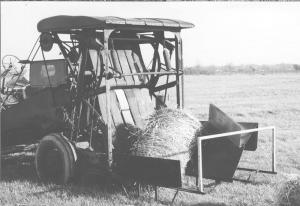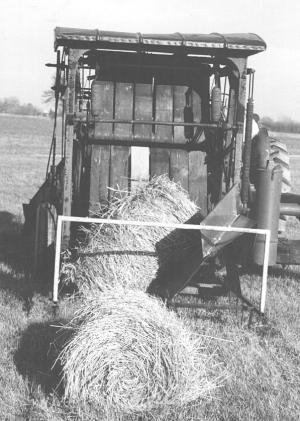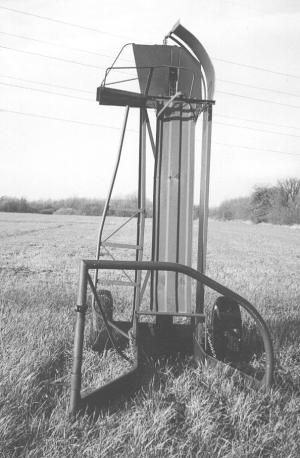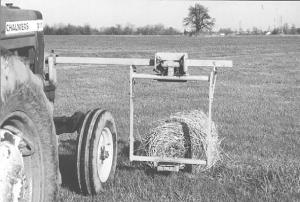Dairy Farmers Still Use 40-Year-Old Round Balers
Peter Grandoni and his two brothers put up 7,000 bales of hay and 3,000 bales of straw each year at their Niagra Falls, Ontario dairy farm. They've used the same equipment continuously for 48 years - small round balers that Allis Chalmers stopped manufacturing in 1963.
If that's not unusual enough, Grandoni invented two of his own attachments to improve his haying operations - a"bale straightener" and a"bale turner". He picks up the bales in the field with a Kneibe bale loader he bought in 1970 (also discontinued).
The AC small round baler produces 3-ft. wide bales that vary from 16 to 22 in. in diameter, depending on the type of hay and density of the windrow.
Since all of the Grandonis' hay storage facilities were built to accommodate the small bales, he and his brothers chose to continue using the old baler, even when many of their neighbors switched to large round bales.
Grandoni owns eight AC balers, four of which are operational. He says a company salesman once told him 189,000 small AC round balers were sold in North America before it went out of production.
Grandoni buys the old balers cheap whenever he can find them. He got one for just $15. The extra units are his only source of parts, and, as each year passes, they are harder and harder to find.
"My father bought our first AC baler in 1952 and we've been using them ever since," says Peter."They shed rain much better than square bales so there's no big rush to get them off the field."
Peter and his brothers built a skid-mounted bale"straightener" that tows behind the AC baler. It simply turns the bales 90 degrees as they come out of the baler so they lay end-to-end in the field. That makes them easy to pick up with a Kneibe bale loader that mounts on front of a hay wagon.
When bales need extra help drying, the Grandonis use their home-built bale turner. It turns bales over so they dry out faster after a rain or if the hay or straw was baled tough.
Grandoni says the antiquated haying system works well for his family.
"It's true that the equipment requires more repairs than most modern systems, since it is already so old and many parts are worn out, but it is also a very low investment, and it suits our hay storage facilities perfectly," he says. "It's an efficient system when you have to rely on the weather so much. I like to think I'm making use of things that would otherwise be scrap metal, and perhaps also keeping haying memories alive for an earlier generation of farmers."
Grandonis' dairy farm is one of very few left in the Niagra Falls area and is located only five miles from the world famous falls.

Click here to download page story appeared in.
Click here to read entire issue
Dairy Farmers Still Use 40-Year-Old Round Balers DAIRY EQUIPMENT & IDEAS Dairy Equipment & Ideas 24-3-23 Peter Grandoni and his two brothers put up 7,000 bales of hay and 3,000 bales of straw each year at their Niagra Falls, Ontario dairy farm. They've used the same equipment continuously for 48 years - small round balers that Allis Chalmers stopped manufacturing in 1963.
If that's not unusual enough, Grandoni invented two of his own attachments to improve his haying operations - a"bale straightener" and a"bale turner". He picks up the bales in the field with a Kneibe bale loader he bought in 1970 (also discontinued).
The AC small round baler produces 3-ft. wide bales that vary from 16 to 22 in. in diameter, depending on the type of hay and density of the windrow.
Since all of the Grandonis' hay storage facilities were built to accommodate the small bales, he and his brothers chose to continue using the old baler, even when many of their neighbors switched to large round bales.
Grandoni owns eight AC balers, four of which are operational. He says a company salesman once told him 189,000 small AC round balers were sold in North America before it went out of production.
Grandoni buys the old balers cheap whenever he can find them. He got one for just $15. The extra units are his only source of parts, and, as each year passes, they are harder and harder to find.
"My father bought our first AC baler in 1952 and we've been using them ever since," says Peter."They shed rain much better than square bales so there's no big rush to get them off the field."
Peter and his brothers built a skid-mounted bale"straightener" that tows behind the AC baler. It simply turns the bales 90 degrees as they come out of the baler so they lay end-to-end in the field. That makes them easy to pick up with a Kneibe bale loader that mounts on front of a hay wagon.
When bales need extra help drying, the Grandonis use their home-built bale turner. It turns bales over so they dry out faster after a rain or if the hay or straw was baled tough.
Grandoni says the antiquated haying system works well for his family.
"It's true that the equipment requires more repairs than most modern systems, since it is already so old and many parts are worn out, but it is also a very low investment, and it suits our hay storage facilities perfectly," he says. "It's an efficient system when you have to rely on the weather so much. I like to think I'm making use of things that would otherwise be scrap metal, and perhaps also keeping haying memories alive for an earlier generation of farmers."
Grandonis' dairy farm is one of very few left in the Niagra Falls area and is located only five miles from the world famous falls.
To read the rest of this story, download this issue below or click
here to register with your account number.










